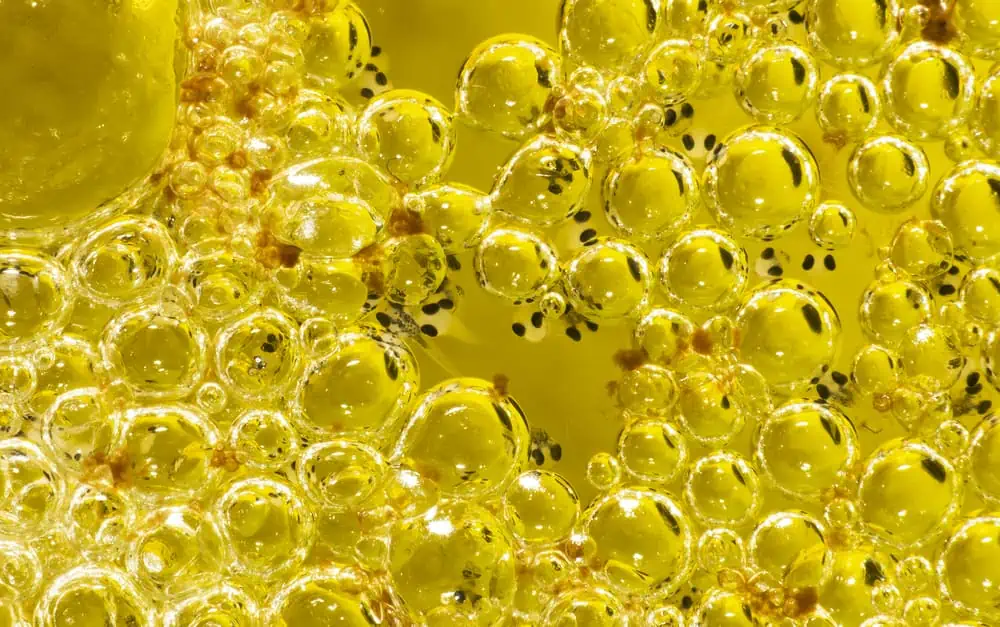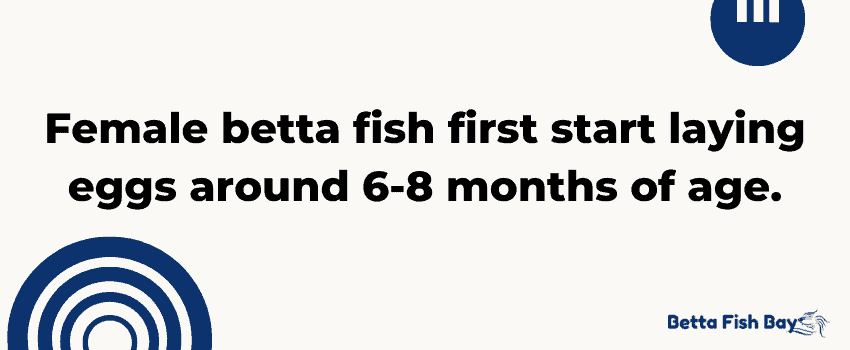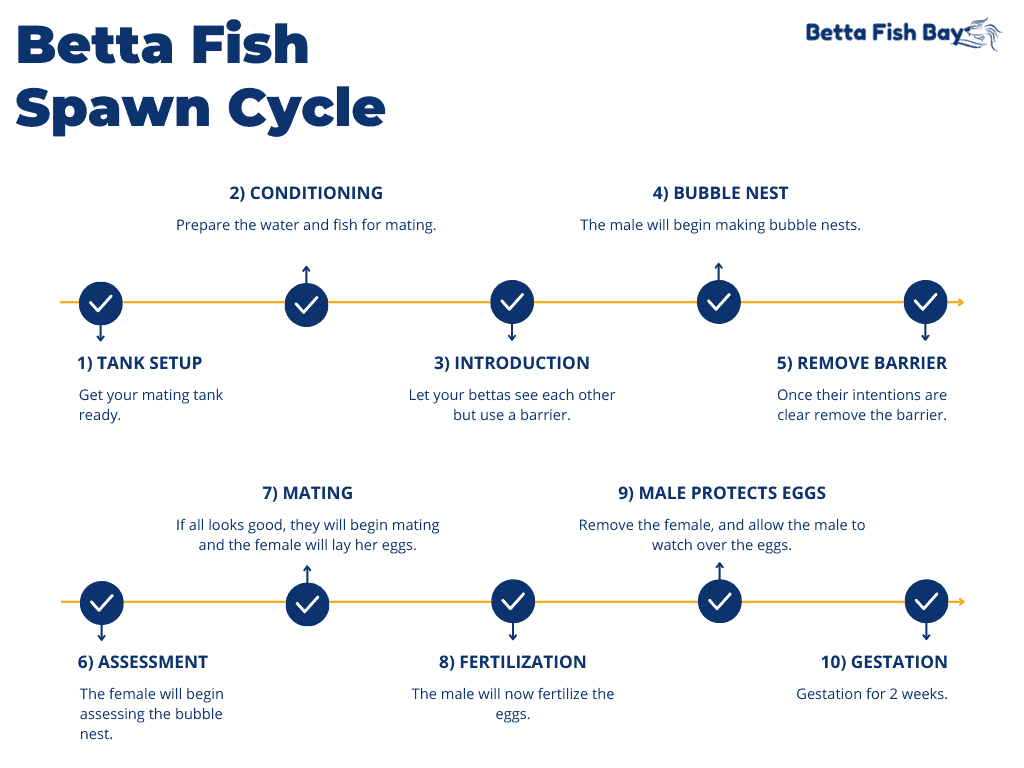Breeding betta fish is an exciting step in your journey as an aquarist.
But there’s so much you need to know about betta fish eggs before getting started.
This way, you’ll recognize problems quickly and always know when things are going well!

Table of Contents
What Do Betta Fish Eggs Look Like?
Betta fish eggs are only about 1mm in diameter.
They often look like tiny white balls and are pretty easy to identify.
If you have a mouth-brooding betta fish, the eggs will be larger. You might see eggs ranging from about 2mm to about 3mm in diameter.
It is extremely common to see variations in their shape. Some may be very circular, while others are shaped more like an oval.
You might also see eggs in different colors. Betta eggs may appear transparent or have a yellow tint.
These color changes are a good tool for understanding the health of your betta eggs.

The Role of the Male Betta in Egg-Laying
There are two main jobs the male betta fish takes care of when it comes to betta eggs:
- Fertilizing the eggs
- Protecting the eggs
In their natural environment, a male betta would have to prove himself as a good mate to the female.
We don’t keep male and female domestic betta fish together long-term due to the serious aggression and stress it would cause.
But to produce eggs, you need both a male and a female in one tank for a short time.
These two fish need separate tanks but will come together in a breeding tank to determine whether to mate.
The male spends hours creating a bubble nest he believes will be suitable for the eggs once they arrive.
Once released into the tank, the female betta will assess the nest. If she approves, mating takes place.
Once the eggs are fertilized, the male betta has a second task: Protecting the eggs.
The bubble nest at the water’s surface provides a safe space for the babies.
If any of the betta fry fall, he puts them back.
He maintains the bubble nest to ensure the betta fry will be protected. The bubble nest also guarantees the babies will have plenty of oxygen available when they hatch.
Identifying Fertilized Betta Fish Eggs
A fertilized betta egg has one or more gray spots on it.
Over a few days, you’ll see some changes in both size and color.
A fertilized egg grows slightly before hatching. It also gains a yellow tint and may turn slightly brown before hatching.
Another telltale sign the eggs are fertilized is when your male betta begins taking care of them.
A betta won’t build a bubble nest unless they know there will be fry.
Conversely, your female betta may deal with non-fertile eggs by eating or re-absorbing them.
However, she may also choose to ignore them.
If you notice the eggs in your tank aren’t fertile, remove them as quickly as possible. This is important to avoid poor water quality.
When to Expect Your Betta Fish to Lay Eggs

Female betta fish do not “get pregnant” but start laying eggs around 6-8 months of age.
The female betta’s gestation period is very short. She can lay eggs every two weeks through her opening, called the egg spot.
Do not expect a female to continue laying eggs like usual when sick or in dirty water.
There are plenty of external factors influencing their fertility and gestation.
Keeping their water clean and maintaining the optimum water temperature are two of many crucial factors.
How to Encourage Egg-Laying in Your Betta Fish
There is a significant link between water temperature and successful mating.
A fully-cycled tank kept at the right temperature is ideal and a necessity for breeding.
Bad water quality and low water temperature cause sickness and kill newly hatched betta fry.
The odds of getting any fertilized eggs with poor water quality are low.
Creating a safe environment with ample oxygen is only step one.
To encourage your betta to lay eggs:
- Cover the tank securely.
- Feed extra-meaty foods for two weeks.
- Introduce the female to the male.
- Give them a semi-private and peaceful environment.
Betta fish tanks always need a cover to keep the fish from leaping right past the water level and out of the aquarium.
But there is a secondary purpose when breeding bettas.
Tightly securing a lid on the tank helps keep the air above the water surface humid. This is great for maintaining a steady environment during the breeding process.
Before introducing your fish, feeding extra protein helps prepare them for breeding.
Giving your betta the strength to reproduce through meaty snacks is a major factor some people overlook!
Introducing the female to the male will start to send signals to her about what is going on.
The male knows what to do! He will create the bubble nest and likely do lots of flaring to get her attention.
Finally, ensure the breeding tank is out of view of other fish. This lets both fish know it is safe to reproduce.
Common Problems with Betta Fish Egg Development
Even in a seemingly secure environment, there are risk factors for losing eggs.
For one thing, female betta fish are not very maternal toward their eggs.
If the female is not removed immediately after producing the eggs, she will likely eat them. She may do this regardless of whether the eggs are fertilized!

The male betta is the protector once those eggs are in the water, so remove the female as soon as possible.
Among numerous factors, a major killer of unhatched betta fry is ammonia.
Harmful substances like ammonia, nitrite, and nitrate stress out and sometimes kill adult bettas.
Baby bettas are much more susceptible to parasites and death from the rise of ammonia levels.
Before introducing the male and female betta, test the tank water to ensure no ammonia buildup.
Finally, first-time breeders make the mistake of breeding betta fish over 14 months of age.
Betta fish are not as likely to reproduce successfully at this age.
Females reach sexual maturity in just a few months. However, for their safety, it’s best to wait until they are 6-8 months before breeding them.
The issue here is it takes a few times for your betta fish to regularly succeed at spawning.
A betta’s first mating experience (and therefore first spawning experience) is likely to be mostly unsuccessful.
Don’t be surprised if the male eats many or all of the eggs. This is normal behavior and means the eggs were not properly fertilized.
What to Do if Your Betta Fish is Not Laying Eggs
If your betta is not laying eggs, the first step is to fix up the tank they’re in.
Your aquarium’s goal is to imitate a natural betta habitat. This means getting the temperature and filtration just right.
Use a gentle sponge filter, and always keep a thermometer on your tank.
We highly recommend using a water testing strip before actually putting your betta fish in the breeding tank to mate.
This helps you see the water’s pH and ensure your fish have clean water free of ammonia.
Water quality is a significant factor in betta fertility, but it’s not the only factor.
Creating a stress-free environment is also crucial.
To do this, plant the tank densely to mimic the betta’s natural habitat.
Consider using an aerator or bubbling sponge filter to give your fish lots of oxygen.
You also need to put a floating log or another safe object in the tank, so your male betta has a good spot to build the bubble nest.
These preparations encourage your fish to mate by letting them know they are in a protected environment.
Finally, your betta will not lay eggs if the male does not have an approved bubble nest for the eggs.
Sometimes the betta fish you choose as a pair are not compatible.
If the female destroys the male’s bubble nest more than once, this is a clear sign they are not a good pair.
The Lifespan of Betta Fish Eggs and Fry
Egg Development
Betta fish eggs hatch within 3 days of being fertilized.
First-time breeders are often surprised at how painless it is to hatch betta fish eggs. But in truth, the fish know exactly what to do.
Once you’ve set the tank up and the fish have successfully mated, all you need to do is remove the female.
Fertilized will show a gray spot, which is the embryo.
Over 2-3 days, the egg will gain a yellow and possibly brown tint.
Two black spots will form. These are the betta fry’s eyes!
Then you get the rewarding experience of watching those baby bettas wriggle around.
Betta Fry Growth
They are not able to swim on their own when they first hatch.
This is why you may see the male betta picking up any fry who fall out of the bubble nest.
He is bringing them back up to keep them safe until they can swim on their own.
It is possible to keep all your betta fry alive in prime water conditions.
However, these little guys are extremely sensitive to changes in temperature and pH.
More so, they are very vulnerable to ammonia spikes.
It is common to lose some of the betta fry within a week of hatching.
The first few weeks are delicate. You need to feed them lots of protein in foods their small bodies can handle.
Once your betta fry becomes free-swimming, the time will start to fly by. They grow very quickly, reaching full size by about 7 months.
However, it only takes a few months for them to mature enough to stop being considered fry.
At this point, they are juvenile betta fish on their way to becoming healthy adults.
The average lifespan for a betta fish is 2-5 years.
So even once those fry reach full size, their lives have just begun!
Understanding the Betta Fish Spawning Cycle
The betta fish spawning cycle is relatively simple, but it’s important not to miss a single step!

Tank Set-Up and Other Preparations
Before you worry about the actual mating process, you must configure the perfect tank setup.
Use a heater to get the temperature to 78-80° degrees Fahrenheit (26-27°vC) as this is ideal for betta fish.
Use a tightly secured cover to keep the air above water level nice and humid.
Some experienced breeders will use plastic wrap because it is easily manipulated and secured.
Plant the tank densely and add a variety of decor just as you would in any other betta tank.
You must put in a floating log or another item near the water’s surface. This helps with the bubble nest the male will create.
Use a sponge filter or another very gentle filter. A strong current will wreck your male betta’s bubble nest and ruin any chances of mating with the female.
Finally, the tank must be fully cycled and free of dangerous chemicals like ammonia.
With the tank ready, you need to also prepare your fish for the spawning process.
Feed bloodworms and other meaty foods for two weeks to give them plenty of strength.
This not only increases the odds of a successful mating experience, but it also ensures the eggs and fry will be healthier.
If either of your betta fish shows signs of illness, you’ll need to wait to breed them. A sick betta cannot lay eggs or fertilize and care for them.
Introducing Betta Fish To Mate
To introduce the betta fish, you have to start with a barrier.
The densely planted tank helps make your fish feel safer, but this is not enough at first.
Some people use a floating breeding box to let the female rest at the top of the tank.
Another option is to use a simple, transparent tank divider. The fish need to be able to see each other.
This way, she takes in her surroundings and has time to adjust.
The male betta needs to be in the tank already because he creates the bubble nest before the female is released.
Positive signs during introductions include:
- Flaring
- Deeper coloring on male
- Vertical bars on female
These are all signs your fish are getting flirty. Though, you likely will not see the vertical bars on the female until later.
This isn’t to be confused with horizontal stripes, better known as betta stress stripes. Read more about those in our article at the link.
Once the intention to mate is clear, your male betta starts building the bubble nest at the top of the tank.
This takes almost an entire day sometimes. It has to be perfect!
Betta Mating
Once the bubble nest is ready, you remove the barrier between your fish.
The female assesses the nest very carefully. When you release her, the nest is the first place she goes.
If she disapproves, she destroys the nest. Let your male build one more and test their compatibility again.
But do not continue pushing it after two attempts. Remind your bettas there are other fish in the sea and move on.
When the female approves, she develops vertical bars on her body. Her ovipositor becomes more visible, indicating she is ready to lay some eggs.
Mating betta fish appear to be embracing each other.
The female often goes a bit limp or stiff, but this is normal behavior and nothing to worry about.
Once she lays the eggs, the male fertilizes them and gets them all situated in the bubble nest.
Read more details about betta fish breeding in our guide written by Betta Fish Bay’s resident vet advisor.
FAQs about Betta Fish Eggs
How many eggs do betta fish lay?
Your betta could lay anywhere from 50-500 eggs. More often, they lay between 50-100 eggs, and many of these do not develop embryos.
The male betta eats any non-fertilized eggs, which leaves you with a much smaller clutch.
How long does it take for betta fish eggs to hatch?
Betta fish eggs hatch within three days of being fertilized. Some experienced breeders say eggs can hatch much sooner. So, it may take anywhere from 1-3 days for the eggs to hatch.
How often do betta fish lay eggs?
Female betta fish can lay eggs every two weeks or so. However, it would be hard on their bodies to mate so often. It is perfectly safe to breed the same betta fish multiple times. Just give her recovery time and give her those meaty snacks for two weeks before she mates.
Can betta fish lay eggs without a partner?
Female betta fish can and will lay eggs without a male betta to fertilize them.
These eggs do not develop into betta fry and will be white or transparent in color. If your betta doesn’t get rid of the eggs herself, you need to remove them from the tank.
What to Remember About Betta Fish Eggs
Many of the same water conditions we worry about with adult fish are barriers to keeping healthy betta eggs and fry.
The hatching process gets easier the more experience you have, though. As does raising betta fry.
After they hatch, though, you need to know how to care for betta fry, so read our article for continuing advice.


